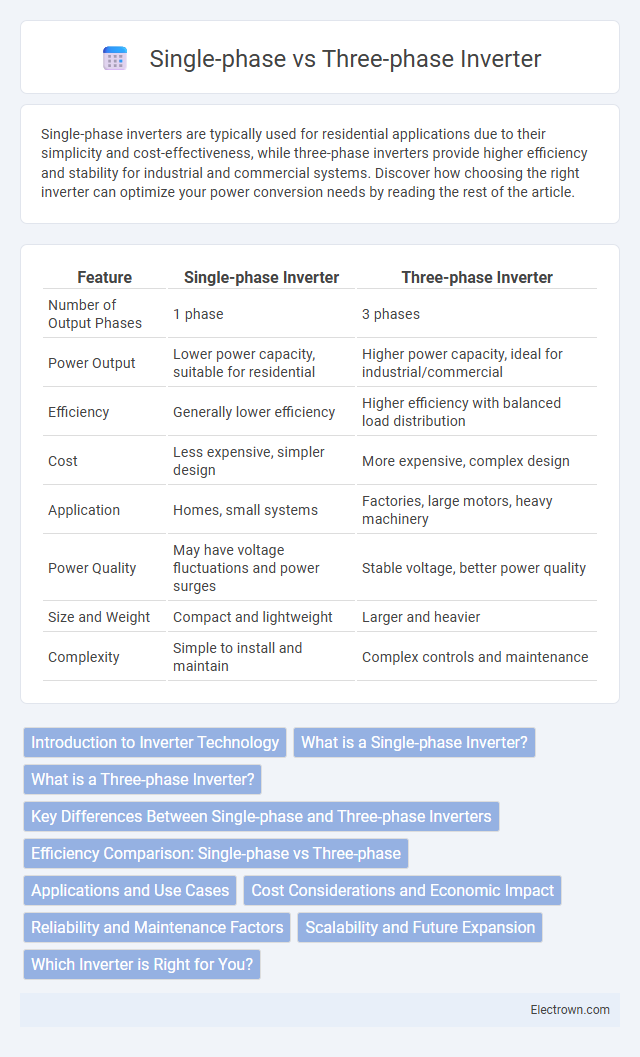Single-phase inverters are typically used for residential applications due to their simplicity and cost-effectiveness, while three-phase inverters provide higher efficiency and stability for industrial and commercial systems. Discover how choosing the right inverter can optimize your power conversion needs by reading the rest of the article.
Table of Comparison
| Feature | Single-phase Inverter | Three-phase Inverter |
|---|---|---|
| Number of Output Phases | 1 phase | 3 phases |
| Power Output | Lower power capacity, suitable for residential | Higher power capacity, ideal for industrial/commercial |
| Efficiency | Generally lower efficiency | Higher efficiency with balanced load distribution |
| Cost | Less expensive, simpler design | More expensive, complex design |
| Application | Homes, small systems | Factories, large motors, heavy machinery |
| Power Quality | May have voltage fluctuations and power surges | Stable voltage, better power quality |
| Size and Weight | Compact and lightweight | Larger and heavier |
| Complexity | Simple to install and maintain | Complex controls and maintenance |
Introduction to Inverter Technology
Inverter technology converts direct current (DC) into alternating current (AC) to power various electrical devices. Single-phase inverters are commonly used in residential applications, providing a simple AC output suitable for low power demands. Three-phase inverters deliver a more balanced and efficient power supply for industrial equipment and large-scale renewable energy systems due to their ability to generate three separate AC waveforms with consistent voltage and frequency.
What is a Single-phase Inverter?
A single-phase inverter converts direct current (DC) into single-phase alternating current (AC) power, typically used for residential or small-scale applications. It provides a single AC output waveform, suitable for powering household appliances and small motors. Single-phase inverters are simpler in design and cost-effective compared to three-phase inverters, making them ideal for lower power requirements.
What is a Three-phase Inverter?
A three-phase inverter converts direct current (DC) into three alternating current (AC) outputs, each out of phase by 120 degrees, enabling balanced power delivery in industrial and commercial applications. Unlike single-phase inverters that provide one AC output, three-phase inverters support higher power loads and enhanced efficiency in motors and complex electrical systems. Your choice of a three-phase inverter can improve power quality and reduce harmonics in three-phase electrical networks.
Key Differences Between Single-phase and Three-phase Inverters
Single-phase inverters convert DC to AC power in a single alternating current output, typically used in residential and small-scale applications with lower power demands. Three-phase inverters produce three separate AC outputs, each phase shifted by 120 degrees, making them ideal for industrial settings and large-scale power systems requiring higher efficiency and balanced loads. Key differences include power capacity, waveform stability, and application scope, with three-phase inverters offering smoother power delivery and better performance in heavy-duty environments.
Efficiency Comparison: Single-phase vs Three-phase
Three-phase inverters generally offer higher efficiency than single-phase inverters due to smoother power delivery and reduced losses in power conversion. Your energy system can benefit from the superior load balancing and lower harmonic distortion of three-phase inverters, especially in industrial or large-scale applications. Single-phase inverters, while simpler and less expensive, tend to have lower efficiency under heavy or variable loads compared to their three-phase counterparts.
Applications and Use Cases
Single-phase inverters are commonly used in residential solar power systems and small-scale applications where power requirements are relatively low and the load is primarily single-phase. Three-phase inverters are essential for industrial and commercial settings, supporting heavy machinery, large motor loads, and three-phase grid connections due to their ability to deliver more balanced power and higher efficiency. Your choice between single-phase and three-phase inverters should align with the specific power demands and application environment to ensure optimal performance and energy management.
Cost Considerations and Economic Impact
Single-phase inverters generally have lower upfront costs, making them suitable for residential applications with limited budgets. Three-phase inverters, while more expensive initially, offer greater efficiency and energy savings for commercial or industrial setups with higher power demands. Your choice impacts long-term operational costs, where three-phase systems often deliver better economic returns through reduced energy losses and improved system reliability.
Reliability and Maintenance Factors
Single-phase inverters typically offer simpler designs with fewer components, resulting in easier maintenance but lower reliability under heavy load conditions compared to three-phase inverters. Three-phase inverters provide better load balancing and smoother power delivery, enhancing system reliability and reducing the likelihood of overheating and component stress. Maintenance for three-phase systems may be more complex due to additional circuitry but results in longer operational lifespan and fewer power interruptions.
Scalability and Future Expansion
Single-phase inverters are suitable for smaller setups and limited load demands, making them less scalable for future expansion. Three-phase inverters offer greater scalability and efficiency, supporting higher power loads and easier integration into expanding electrical systems. Your choice affects the system's ability to grow with increasing energy needs and ensures long-term compatibility with evolving infrastructure.
Which Inverter is Right for You?
Choosing between a single-phase and three-phase inverter depends on your power needs and application. Single-phase inverters are ideal for residential use and small-scale systems, providing efficient power for typical household appliances. Three-phase inverters deliver higher power output and are better suited for industrial or large commercial setups, ensuring stability and efficiency in managing heavy electrical loads for your operational requirements.
Single-phase vs Three-phase Inverter Infographic

 electrown.com
electrown.com